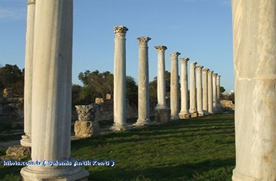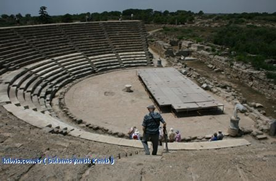Salamis - Famagusta
|
|||
Some 9km north of Famagusta lies the ancient city Salamis, the most important archaeological site on the island. The exact origins of Salamis remains uncertain but it is believed to have been founded by Teucer, exiled by his father King Telamon after the Trojan wars around the twelfth century BC. It prospered steadily and by the eighth century BC it had grown into the most important city-state on the island. Within a further two centuries it was minting its own coinage, the first city-state on the island to do so. From around this period Salamis came under Persian control and remained so until Alexander the Great came on the scene in 334 BC to destroy the might of the Persian Empire. After the early death of Alexander, Salamis came under the influence of the Ptolemaic kings and turbulence continued. The arrival of the Romans brought more peace and stability and, despite the rank of capital city passing to Paphos, Salamis developed as a major commercial centre and figured prominently in the rise of Christianity on the island. The Jewish community, feeling threatened by the rise of Christianity, revolted in 116 AD with terrible consequences which led to their slaughter or expulsion from the island. Earthquakes thoughout this period, up to the fourth century, hampered the development of the city but decline eventually set in with the harbour silting up and the rise to prominence of nearby Famagusta. An extensive site remains for the visitor to explore and there are notice boards here and there to show walking routes to the outlying remains. If you plan to explore the more distant archaeological remains, it is very important to carry sufficient water for everybody in the party. The Gymnasium complex and baths is first encountered as you enter the site. The eastern colonnade, once covered, is flanked by two plunge pools. The northerly most one of these is surrounded by headless statues, the heads destroyed by Christian zealots protesting against the worship of idols. The plan of Salamis given on entry shows the location of the various rooms in this complex including the hot room, the hot water baths and the latrines. Moving on from the Gymnasium complex, a largely unexcavated amphitheatre gets scant notice since the impressive theatre nearby is so eye-catching. Built in the time of Augustus, the theatre suffered damage in the 4th century. Some 50 rows of seats held over 15 thousand spectators who watched performances on the raised stage backed by statues. The outlying area offers plenty more archaeological remains to see including the Ayios Epiphanios Basilica built by Epiphanios when he was Bishop of Salamis. Apart from having the distinction of being the largest basilica on Cyprus, there is not too much to see. Similarly, there are Roman villas, a large Roman Agora, Byzantine cisterns but again these are lesser remains. Perhaps the most evocative remains of all in the outlying areas is the 4th century Kampanopetra Basilica located almost on the sea shore. Salamis is easy to be reached from Kyrenia or Famagusta and the most popular zone for the tourists.
|





